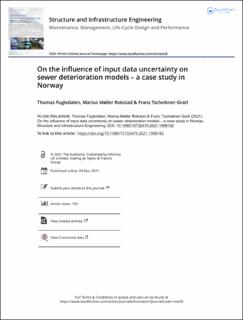| dc.contributor.author | Fugledalen, Thomas | |
| dc.contributor.author | Rokstad, Marius Møller | |
| dc.contributor.author | Tscheikner-Gratl, Franz | |
| dc.date.accessioned | 2021-11-11T08:30:23Z | |
| dc.date.available | 2021-11-11T08:30:23Z | |
| dc.date.created | 2021-11-09T10:29:42Z | |
| dc.date.issued | 2021 | |
| dc.identifier.issn | 1573-2479 | |
| dc.identifier.uri | https://hdl.handle.net/11250/2828996 | |
| dc.description.abstract | Visual inspection is currently the industry standard for assessing sewer and stormwater pipelines – a method prone to uncertainties as shown by previous studies. The data gathered from the visual inspection procedures is the main information base on which rehabilitation and replacement strategies are founded in current practice. Consequently, this study evaluates the quality of visual inspection data by quantifying the uncertainty and assessing its impact on the output of a deterioration model. The study was carried out by re-classifying pipe condition classes using the same video footage and transferring differences in the classifications into a distribution that was used as a measure of input data uncertainty. This quantified uncertainty was then propagated into a deterioration model using a Monte Carlo approach to assess its impact on the model behaviour. Results show that there is a considerable uncertainty in condition classes coded according to the Norwegian standard, and that it is comparable to uncertainties estimated in other studies using various European coding systems. The uncertainty assessment indicates that the uncertainties have a considerable impact on the model predictions, which in consequence demonstrates that the uncertainty in the visual inspection methodology can heavily influence the decisions for rehabilitation and replacement strategies. | en_US |
| dc.language.iso | eng | en_US |
| dc.publisher | Taylor & Francis | en_US |
| dc.rights | Attribution-NonCommercial-NoDerivatives 4.0 Internasjonal | * |
| dc.rights.uri | http://creativecommons.org/licenses/by-nc-nd/4.0/deed.no | * |
| dc.title | On the influence of input data uncertainty on sewer deterioration models – a case study in Norway | en_US |
| dc.type | Peer reviewed | en_US |
| dc.type | Journal article | en_US |
| dc.description.version | publishedVersion | en_US |
| dc.source.journal | Structure and Infrastructure Engineering | en_US |
| dc.identifier.doi | 10.1080/15732479.2021.1998142 | |
| dc.identifier.cristin | 1952650 | |
| cristin.ispublished | true | |
| cristin.fulltext | original | |
| cristin.qualitycode | 1 | |

